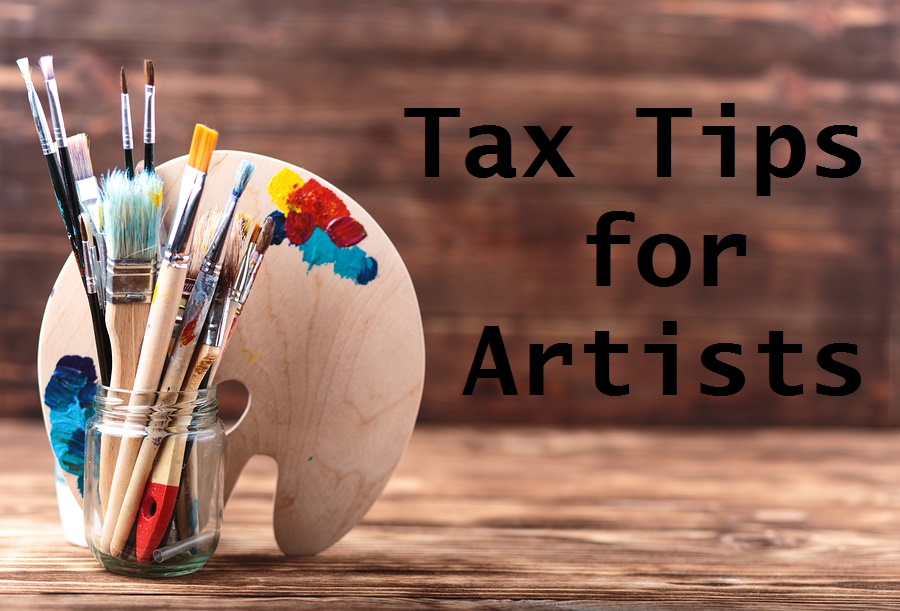
If you’re selling your art, you need to think about taxes. Taxes are different for hobbies than for businesses. It’s important to know what you have.
Are you a Hobby or a Business?
If you’re reading this post, you’ve probably made some money on your art. Maybe you sold a few paintings. At what point, does your hobby become a business? Taxwise, you need to decide which is better for you. Another consideration is: What does the IRS think?
Hobby Income Taxes Hobby income is taxed at your regular income tax rate. It goes on line 21 of your 1040 tax return. Now in the past, you might have been able to deduct some of your hobby expenses on your Schedule A of your tax return, but beginning this year (2018) that option is no longer available. So if your federal income tax rate is 22%, then your tax on that $5,000 will be $1,100. (5000 x .22 = 1100)
Business Income Taxes Business income is taxed at your regular tax rate plus the self-employment rate. The self-employment rate is 15.3%. So, if you’re in the 22% tax bracket, the tax rate on your business income would be 37.3%. That means that the $5,000 you made as hobby income would now be taxed $1,865. Which sounds awful at first blush.
But the advantage to being taxed as a business is that you get to write off your business expenses directly against your income. Let’s say you had $3,000.00 in business expenses, then your tax would only be $746.
($5,000 income – $3,000 expenses = $2,000 net income to tax)
($2,000 taxable income x 37.3 percent tax rate = $746 in taxes)
Artists often have a lot of business expenses, so being able to claim your art income as a business can be a good thing. This is especially true if you have a business loss. You can use your self -employed business loss to offset other income – like wages you receive from another job – on your tax return. (Be sure to read about the Qualified usiness Income Deduction “QBI” further on though because there’s more to business taxes than just this.)
1099MISC If you receive a 1099 MISC that shows income in box 7, the IRS will automatically count you as being self-employed – even if you have another job somewhere else. If you teach an art class or win a prize you may receive a 1099.
The 1099 also proves you have income if you need proof of income to obtain an earned income tax credit. You don’t have to mail your 1099s in with your tax return, but you’ll want to hold on to them. They can come in very handy.
What will be different about your tax return now that you’re a professional artist instead of a hobbyist?
You won’t need to incorporate or file a special business return. Most people will just include their art business information on Schedule C which becomes part of your 1040 tax return. It will show your business income and expenses. Form Schedule SE will show your self-employment tax owed. You will need to file the long form when filing the Schedule C – no more 1040 EZ.
Common Tax Deductions for most Small Businesses
Advertising
Home Office expense
Mileage
Supplies, etc.
Common Tax Deductions for Artists
Art supplies
Membership Dues
Classes and Workshops
Show Fees
Software fees
Studio
A word about making Estimated Tax Payments
If your art business is successful, you’re going to be making money. And if you make money – you have to pay taxes. If you’re going to have a tax balance due of more than $1000.00 federal, you should start making estimated tax payments. . A good rule of thumb – if you make over $6,000.00 after deducting your expenses then you should make estimated payments
Your two best Tax Deductions
Mileage and Home Office (Studio). These deductions are great because they are expenses that you already are paying for anyway.
Mileage
If you want to claim mileage, you must keep a mileage log. For every business audit I have ever worked on – the IRS requested the mileage log. The IRS wants to know how many total miles you put on the car, not just your business miles. This is the most forgotten about issue but it’s really helpful to know.
Home Office (Studio)
You don’t need a desk and a computer for your home office. It could be a storage space for your art, the place where you paint or the room you throw pots in. It doesn’t have to be a separate room in your house, it can be a section of a larger room. It can also be very small.
The most important reason for claiming a home office is so that you can claim your mileage to your shows. The important issue is “regular and exclusive”. Maybe you paint in your kitchen – that’s fine but you can’t claim your kitchen as a home office because you cook dinner there. You have to use the space exclusively for your art business in order to deduct it. So, if you paint in your kitchen, you need another space to maybe store your art that you can claim as your “exclusive” working space.
Issues of selling Art in multiple states/cities
When you do a show in the City of St. Louis, the City expects you to pay city sales tax. If you sell in Illinois, then you’re expected to pay Illinois sales tax as well. Generally, if you’re selling all over the country, you’re expected to file state returns in those states. Often, if you’re at an art show, the event coordinator will instruct you about collecting sales tax for that event. If you sell art online – if you sell out of state, you generally do not have to collect sales tax. If you sell in state you do. But be careful! The Supreme Court recently ruled in South Dakota v. Wayfair that you don’t have to actually have a physical presence in a state to be required to collect sales tax. This court case will have a far reaching effect of sales taxes across the country so you’re going to want to keep your eyes open and be aware of changes in sales tax laws in any states you sell in.
You will need a retail sales license in order to collect sales tax in Missouri. It costs $25 for the bond and is returnable after a few years. You can apply for the license at https://dors.mo.gov/tax/coreg/index.jsp
This is really important. If you collect sales tax – you must remit it to the taxing agency. You can’t keep it. That sounds like a no-brainer, but people have been audited for that. You don’t want that!
Should you become an LLC? Generally, artists tend to be “individuals”. An LLC is a limited liability company. The idea is that your liability – meaning if someone wants to sue you – is limited. If you decide to become a Limited Liability Company anyway there are rules you must follow.
- Get a Federal EIN number.
- Set up a bank account for the LLC.
- Run all of your business income and expenses through that bank account.
- If you don’t do all those steps, you’ve “pierced the veil” of the LLC and you’re just wasting your time and money.
“Piercing the veil” means that someone could still sue you personally even though you have an LLC. If you’re not going to bother with the separate bank account and getting a separate EIN number, you’re not protected by your LLC.
Identity Theft Unfortunately, identity theft is the number one tax crime these days. As a sole proprietor of your art business, you may be asked to complete paperwork requiring your tax ID number. That’s usually your social security number. You can protect your social security number by getting an Employer Identification Number for yourself from the IRS. It’s free and it’s easy. Just go to www.irs.gov. It takes about 5 minutes to do.
DBA Doing Business As You might have a business name that you want people to use, like “Wanda’s Watercolors”. You can file paperwork for “doing business as” with the Secretary of State’s office. It only costs $7.00. That way you can receive and deposit checks under your business name.
Helpful Links:
Starting an LLC or filing a fictitous name registration – Secretary of State office: http://www.sos.mo.gov/business/corporations/startBusiness.asp
Registering your business for a sales tax ID number with the MO Department of Revenue: https://dors.mo.gov/tax/coreg/index.jsp
Apply for an employer identification number with the IRS:
Volunteer Lawyers Accountants Association – VLAA provides free services/assistancewww.vlaa.org
QBI – What you need to know about your business income for 2018 – 2025
As a small business owner, for 2018 there is something called the Qualified Business Income Deduction. QBI for short. QBI is a 20% deduction off of your business income from your taxable income. It’s really pretty awesome.
Simply speaking – remember that example above where you have $5,000 of income, but after expenses you only had $2,000 of taxable income? Well, with the QBI deduction, you still pay your self-employment tax on the full $2,000 – so that’s 15.3% = $306.
But then, you get to deduct 20% from the $2,000 before you pay the regular tax. In this example you’d take 2000 – 400 = 1600, then take 1600 times 22% and you get $352. So, really, instead of paying $746 like in the earlier example, you’ll only pay $658 – a savings of $88.
That doesn’t seem like much, but if your art business had a net income of $50,000, at the 22% tax bracket you’d be saving $2,200! The QBI can be a really important tool for you.
But not everyone can qualify for the QBI deduction. For an automatic QBI deduction – meaning – you don’t have to jump through any hoops to qualify, a single person would have to have income below $157,500. A married personal would need to be below $315,000.
You might be thinking – I’m just starting in the business, I’m not Jasper Johns. I don’t make anywhere near those numbers with my art. But I’m talking about your total income. So if you’ve got a day job, or a spouse with a high income, your QBI deduction could be lost.
But there are strategies for QBI if your income exceeds those limitations. That’s where it makes sense to talk with your accountant about what’s best for your situation.
With the new Tax Law, should I Incorporate?
For most people, I would say there’s no reason to. Unlike an LLC – which still allows you to file your tax on your personal return, a corporation is a completely separate entity with a separate tax return, a separate tax rate, and separate and very strict rules. There was a lot of buzz on the internet about forming corporations with the new tax rate, but the final bill, especially with the QBI deduction, pretty much evened the playing field for the business taxes. If you’re thinking about incorporating, be sure to sit down with your accountant and run all the numbers side by side before making any drastic decisions.


